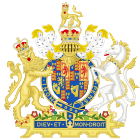James Waldegrave, 1st Earl Waldegrave facts for kids
Quick facts for kids Lord Waldgrave's Estate Act 1691 |
|
|---|---|
| Act of Parliament | |

|
|
| Long title | An Act to enable Trustees of the Right Honourable James Lord Waldegrave to make Leases, and grant Copyhold Estates, for the Payment of the Arrears of Annuities of Henry Lord Waldegrave his Father, deceased. |
| Citation | 3 Will. & Mar. c. 18 |
| Dates | |
| Royal assent | 24 February 1692 |
James Waldegrave, 1st Earl Waldegrave (born 1684, died 11 April 1741) was an important English diplomat and nobleman. He held the title of Earl Waldegrave. From 1730 to 1740, he served as the British ambassador to France. This meant he represented Britain in France, helping to keep good relations between the two countries.
Contents
Early Life and Family
James Waldegrave was the son of Henry Waldegrave, who was also a nobleman. His mother was Henrietta FitzJames. Henrietta was the daughter of King James II of England.
James grew up and received his education in France. In 1690, when he was just six years old, he inherited his father's title, becoming the 2nd Baron Waldegrave.
Marriage and Children
On 20 May 1714, James Waldegrave married Mary Webb. Mary was the daughter of Sir John Webb, 3rd Baronet. Sadly, Mary died in 1719 during childbirth. Together, they had three children who survived:
- James Waldegrave, 2nd Earl Waldegrave (1715–1763)
- John Waldegrave, 3rd Earl Waldegrave (1718–1784)
- Lady Henrietta Waldegrave (1717–1753), who married twice. Her first husband was Lord Edward Herbert. Her second husband was John Beard, a famous singer at the Covent Garden theatre.
Public Service
After his wife passed away, James Waldegrave changed his religion. He had been raised as a Roman Catholic, but he converted to Anglicanism. This change allowed him to take his place in the House of Lords, which is part of the British Parliament.
Diplomatic Career
James Waldegrave had a busy career serving his country.
- He was a Lord of the Bedchamber for a short time in 1723. He held this position again from 1730 to 1741. A Lord of the Bedchamber was a personal attendant to the King.
- In 1725, he was an ambassador to France for a special mission.
- From 1727 to 1730, he served as the British ambassador to Austria.
- His most important role was as ambassador to France from 1730 to 1740. He took over this job from Horatio Walpole.
Charity Work
Even though he spent a lot of time in France as an ambassador, James Waldegrave still visited London often. He became one of the first Governors of a new charity called the Foundling Hospital. This hospital was created in 1739 to care for abandoned children.
In 1729, James Waldegrave was given the higher title of Earl Waldegrave. When he died in 1741, his eldest son, also named James, inherited his title.
Hever Castle
Sir James Waldegrave inherited Hever Castle in Kent. This castle had been owned by the Waldegrave family for 160 years. However, Sir James felt the castle was too small for him. So, in the early 1700s, he sold it to Sir William Humfreys, who was the Lord Mayor of London in 1714.


